Purpose of A Genogram – Uncovering The Family Dynamics
Imagine you’re holding a map, one that doesn’t just show you where you came from, but also patterns that have traveled through generations. In case you didn’t know, that’s essentially the purpose of a genogram . It’s not your typical family tree. It’s a comprehensive illustration that depicts familial relationships, medical history, and inherited behaviors all at a glance. 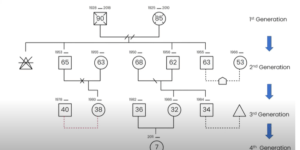
Purpose of a Genogram
The roots of the genogram stretch back to the works of psychiatrists in the 1970s. They were searching for a more in-depth understanding of family systems and structures. Murray Bowen, one of the pioneers in this area, emphasized the purpose of a genogram in theory.
Bowen believed in the importance of family in the psychotherapeutic process. So, Bowen’s genogram was, and still is, an extension of that philosophy. It offers a visual shortcut to uncover family dynamics.
In settings where understanding of individual context, such as in psychological counseling or genealogical research, genograms are ostensibly valuable. They go beyond names and dates. In fact, they capture the essence of people’s lives, their health, and their connections.
Purpose of Understanding Family Dynamics
It is this complexity, laid out in a clear format, that makes the genogram a vital tool in various fields. It blends the lines between psychology, medicine, and history. In essence, a genogram is a powerful multi-purposed trifecta. Studying your DNA and genetics is another option to increase your knowledge base. A 23&me DNA kit works just fine.
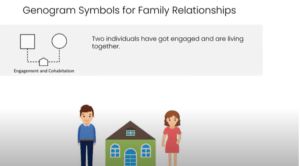
Multi-Layered Purpose
Beyond the Family Tree
If you’re interested in mapping out your family heritage, you might initially think of a family tree. But a genogram goes several steps further. While a family tree typically outlines the biological lineage, a genogram dives into the intricate web of relationships and interactions within a family. It’s a comprehensive tool that records life’s complexities beyond names and dates. Genograms are aslo multidimentional tools.
Multidimensional Purpose
Here’s the deal: genograms are multidimensional. They illustrate not only familial connections, but also include the following markers:
Patterns of illness Psychological factors Social behaviors. This list includes a plethora of examples such as:
- Chronic illnesses
- Addiction tendencies
- Emotional quality of relationships
- Individual life events
- Divorces
- Remarriages.
You’re going to find out about common patterns that run through generations. This will give you a panoramic view of your family’s legacy through charts, symbols and diagnostic tools. In addition, you will also discover if you or someone in your family circle have been physically, mentally or emotionally abused. These are underlying causes that are sometimes not so easy to detect, believe it or not.
Charts, Historical Records and Diagnostic Tools
These detailed charts serve as more than just historical records. They’re potent diagnostic tools. Professionals in therapy and healthcare use genograms to predict potential issues in a person’s past and future life. 
Backgrounds Inform the Future
For instance, by noting patterns of mental health conditions, professionals identify clients at risk and propose early interventions. It’s about looking at a person’s background to fugure out future strategies.
Detangling the Knots in the Family
Moreover, genograms offer insight into the emotional structures and bonds within a family. Understanding these patterns leads to therapeutic breakthroughs. This knowledge fosters a better comprehension of intrafamily support systems or conflicts. It becomes a way to visualize invisible ties and perhaps untangle some of the knots in family relationships. Genograms zoom in on specific behaviors and patterns
Bringing Patterns into Focus
Genograms in Psychological Assessment
I want to share something fascinating with you about genograms and their crucial role in psychological assessment. Now, imagine having a tool that has depth to exam the past to change the future. Take emotional patterns for example.
Emotional Patterns Under the Microscope
Genograms don’t just recount your family lineage. They also shed light on the emotional and interactive patterns that thread through generations. That’s exactly what a genogram brings to the table in the context of therapy and counseling. For example, they may be underlying causes or family conflict issue that stem from gaslighting or other undermining conditions.
Therapists Unlock Hidden Patterns
So, here’s how it works: therapists use genograms to identify recurring behaviors and psychological conditions within a family. Think of it as a detective uncovering the hidden connections and patterns that unlock understanding of an individual’s issues. 
By mapping out relationships, it provides a clear visual of conflicts, bonds, and social networks. This process is extremely instrumental in behavioral therapy. These undercurrents undermine healthy family relationships. On the other hand, Genograms highlight strengths and weaknesses.
Highlight Strengths and Self-Awareness
Moreover, genograms aren’t only about identifying problems. They are equally potent in highlighting strengths and support systems within a family’s structure. This balanced perspective empowers not only the therapist, but also the client. This leads to insight and healing.
The Pathway to Healing
This therapeutic alliance enhancing self-awareness and deepening the comprehension of how familial ties impact one’s life. It’s an exploratory journey that often leads to surprising revelations and pathways to healing. Brokenness in a family is mended.
Genograms assist individuals in recognizing and mitigating potential issues before they fully manifest. It’s truly an invaluable asset in progressing toward mental well-being.
But, don’t worry too much about all the intricate details. When we transition into the healthcare arena in the next section, you’ll learn how seamlessly genograms blend into the domain of tracing hereditary health conditions. Genograms greatly impact our healthcare and overall well-being.
The Genogram in Healthcare
Tracing Health Conditions
Have you ever noticed patterns of illnesses within families? For example: why does heart disease or diabetess seem to ‘run in the family’? Well, that’s where a genogram comes into play in a big way in the healthcare setting.
A Genogram is not simply about plotting out your ancestry. It’s about mapping potential health battles that might lurk in your genes. Genograms detect hereditary conditions passed down through the bloodline.
Detective’s Purpose of Genograms
Genograms allow healthcare professionals and patients to visualize medical issues that recur through generations. However, they are designed as an essential tool for genetic counseling. 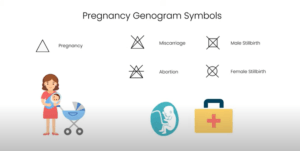
In fact, think of a genogram as a detective’s map. It highlights a hereditary condition passed from your grandparents, to your parents, and potentially to you or your children.
This isn’t just about curiosity. It’s more about proactive health management. Identifying these patterns leads to preventive care strategies.
Here is what prevention includes:
- Early screenings
- Lifestyle adjustments
- Targeted medical interventions.
By understanding the hereditary predispositions, individuals begin to take charge of their health with informed decisions. One of the best things to help you identify hidden health conditions and family conflicy is genetic counseling.
Genetic Counselors Available
Now, if you’re feeling intimidated by the idea of creating a genogram, remember that support is always there for you. Genetic counselors, for example, are trained specifically to help you piece together this puzzle. They are adept at tracing your family’s health narrative. Moreover, the insights they glean will shape your health journey toward a better outcome.
In the upcoming section, I’m going to walk you through the steps of creating your own genogram. This isn’t just an exercise in family history It’s an investment in your future well-being. You’ll discover that with the right tools and a bit of patience, you will craft a genogram that speaks volumes about your family’s health saga. So, why not create your own intergenerational map.
Creating Your Own Genogram
A Step-by-Step Guide
I’m going to walk you through making your very own genogram. So, get ready to unlock the hidden stories within your family narrative. Don’t worry too much about getting it perfect the first time. You always be able to refine it as you learn more. The key is cgoosing the right genogram tools.
Choosing the Right Tools
First up, you’ll need the right tools. There are various software options available, both free and paid. These tools help you layout and customize your genogram. Choose something that resonates with you and fits your level of tech-savviness. It all starts with a pen and paper.
Start Journaling About Your Immediate Family
With your tools in hand, you’ll start by jotting down what you already know. This includes immediate family and extends to relatives you don’t regularly interact with. If you want to, reach out to family members to fill in gaps. Just remember to approach sensitive topics with care. Take notice of specific behavioral patterns.
Identify Markers and Specific Patterns
Now, as you place each person on your genogram, you’re going to mark down any medical conditions, psychological patterns, and the quality of relationships. This isn’t just about names and dates. It’s about getting a clearer picture of who you are and where you come from. Reflect on your findings and discuss them with your family.
Reflect on the Patterns that you See
Finally, after you’ve compiled and organized all this information, take a step back. What patterns do you see? Are there any health concerns to discuss with a professional? Reflect on what your genogram reveals about you and your family, and consider how it might inform your future choices. Next, I’ll share my genogram experience.
My First Genogram Project
While completing my sociology studies I had to do a family genogram. There were specific instructions that we had to follow precisely. For example, I had to contact family members and go back 3 or 4 generations if possible. This included phone calls, text, emails, snail mail or whatever means in order to glean information for the assignment.
Needless to say, it was a colossal ordeal. I had the opportunity to unearth some juicy information. However, it was a lot of fun learning about how traits, traditions, customs, behaviors, characteristics, core values and beliefs systems are handed down from generation to generation. 
My British Ancestors
I finally pieced together all the data that I received from my genogram project only to discover that my maternal grandpa was from British descent. Yes, he was British and he was a chrisitian pastor. This is what I was told by everyone of his children that I interviewed. Now I realize where part of my beliefs stem from.
Belief Systems Handed Down
Due to the fact that my mum was brought up under the leadership of a southern women of semi-religious Cherokee descent and an English pastor, she made sure to pass her belief systems onto us, her children as well.
Going to church was non-negotiable. Thus, we were very active in the church. We had to attend all church meetings, had to participate in every play, every vacation bible school in town and every parade. Even when she couldn’t attend herself, we had to attend. By the way, mum was a regular tither to church and she was well-respected in the community. She also modeled cultural competence, tolerance and taught us how to respect everyone’s culture, traditions, customs, and personal beliefs.
My Multi-Cultural Experiences
My mum eventually joined other factions outside of the Baptist faiths. It was a common thing for us to have catholics, muslims. and Jews over for dinner. Thus, many of mums friends were from other countries and cultures. India, German, Dutch, or Australian.
By the time I entered high school mum was deep into Billy Graham’s Evangelism and other worldwide religions in search of the true one. She had two besties from Australia that she met at the yearly evangelist celebration. They were regular guests at our home.
I highly recommend every one to experience the genogram process. It is a great learning curve in intergeneration history. You no longer question who you are and where you came from. You see where your behavior patterns, attitudes, characteristics, core values and belief systems come from. 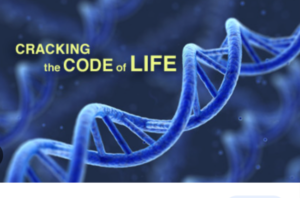
Benjamin Franklin’s Quote
Was Benjamin Franklin’s predictions right when he coined the phrase “An ounce of prevention is worth a pound of cure? Looks like he was right on the money, right? At least in terms of Murray Bowen’s Genogram process.
According to Bowen, the phrase “an ounce of prevention is worth a pound of cure” is often attributed to Benjamin Franklin, one of the Founding Fathers of the United States. He used this phrase in a letter addressed to the citizens of Philadelphia in 1736, advising them to take precautions against fire hazards.
An Ounce of Prevention and Fire Hazards
What Franklin meant by this phrase is that it is better to take preventive measures to avoid problems than to deal with the consequences after the problems have occurred. In other words, investing a small amount of effort or resources in prevention can save a lot of time, money, and energy that would otherwise be required to solve the problem later.
For example, in the context of fire safety, installing smoke detectors and having fire extinguishers readily available (an ounce of prevention) can help prevent or minimize damage caused by a fire, which would require far more resources to repair (a pound of cure).
When applying this concept to the process of creating a genogram to explore family dynamics, it emphasizes the importance of understanding and addressing potential issues within the family system before they escalate into more serious problems.
A genogram is a visual representation of a family tree that includes information about relationships, emotional patterns, and significant events across multiple generations.
By creating a genogram and analyzing the family dynamics, a therapist or family member can identify patterns of behavior, communication styles, and potential sources of conflict.
An “ounce of prevention” allows for a proactive approach to addressing family issues, such as:
1. Recognizing and modifying unhealthy communication patterns
2. Identifying and breaking negative cycles of behavior that may be passed down through generations
3. Addressing unresolved emotional issues or traumas that impact family relationships
4. Promoting open communication and fostering a deeper understanding among family members
By investing time and effort in exploring family dynamics through a genogram, families can work on preventing the escalation of problems and building stronger, healthier relationships. This proactive approach is more effective than waiting until conflicts or issues become more severe and require a “pound of cure” in the form of intensive therapy or intervention.
Genogram Symbols
Dependent on whether you use the free or paid version, the outcomes are similar.
A genogram is a pictorial representation of a person’s family relationships and medical history. It is a valuable tool used by mental health professionals, such as family therapists and counselors, to gather information about a client’s family background, identify patterns of behavior, and gain insight into family dynamics.
The concept of the genogram was developed by Murray Bowen, a prominent family therapist, in the 1970s.
Symbols used in a genogram:
1. Squares represent males
2. Circles represent females
3. Lines connecting squares and circles represent family relationships
- Horizontal lines: marriage or long-term committed relationships
- Vertical lines: parent-child relationships
- Diagonal lines: family members who are deceased
4. Dotted lines represent informal relationships, such as non-marital or distant relationships
5. Jagged lines represent conflict or cutoff in relationships
6. An “X” through a symbol indicates a deceased family member
7. Shading or coloring symbols can represent specific characteristics, such as substance abuse, mental health issues, or chronic illnesses
Importance in Family Therapy and Counseling
1. Identifies family patterns: Genograms help therapists identify recurring patterns of behavior, relationship dynamics, and communication styles across generations.
2. Reveals family history: By mapping out a client’s family history, therapists can gain insight into significant events, such as divorces, deaths, or major life transitions, that may have impacted the client’s development and current functioning.
3. Facilitates discussion: Genograms serve as a visual tool to facilitate discussions about family relationships, allowing clients to share their experiences and emotions related to their family history.
4. Highlights strengths and resources: Genograms can also reveal positive aspects of family relationships, such as supportive bonds or resilience in the face of adversity, which can be leveraged in therapy.
5. Aids in treatment planning: By understanding a client’s family background, therapists can develop more targeted and effective treatment plans that address specific issues and concerns.
How genograms help families:
1. Increased self-awareness: Creating a genogram can help family members gain a greater understanding of their family history, patterns, and dynamics, fostering self-awareness and personal growth.
2. Enhanced communication: Discussing the genogram in therapy can encourage open communication among family members, allowing them to express their thoughts and feelings about their relationships and experiences.
3. Problem-solving: By identifying patterns of behavior or sources of conflict, families can work with therapists to develop strategies for resolving issues and improving relationships.
4. Strengthening family bonds: Genograms can highlight the importance of family connections and encourage family members to appreciate and nurture their relationships.
How to Get a Genogram
Genograms are typically created with the assistance of a mental wellness professional, such as a family therapist or counselor. The process involves gathering information about family members, their relationships, and significant life events through interviews and questionnaires.
This information is then used to construct the genogram, which is updated and refined as therapy progresses. Some online tools and software programs are also available for individuals to create their own genograms. However, working with a professional is recommended for a more comprehensive and therapeutically meaningful experience.
https://www.youtube.com/watch?v=bVqmukYhF2A
Final Thoughts
I really hope that this guide sparks your curiosity and encourages you to delve into your own family’s history. Remember, your genogram is more than a record—it’s a blueprint of your heritage that guides you toward a healthier, more self-aware future.
Founder, Rachele
(w) mybluegenes.com
(e)rachele@mybluegenes.com

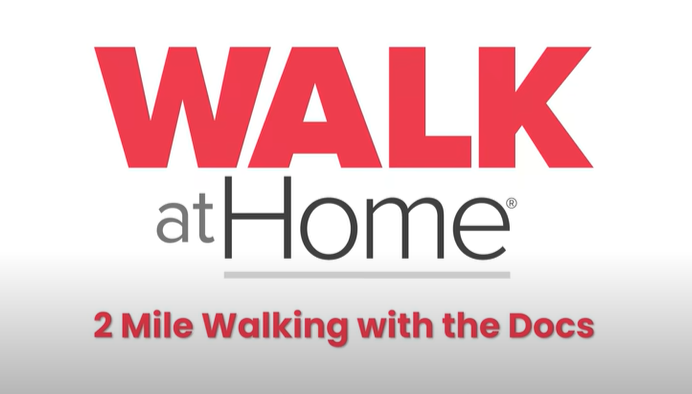
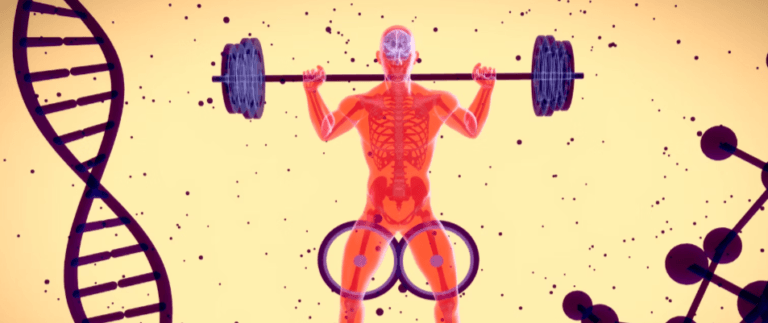
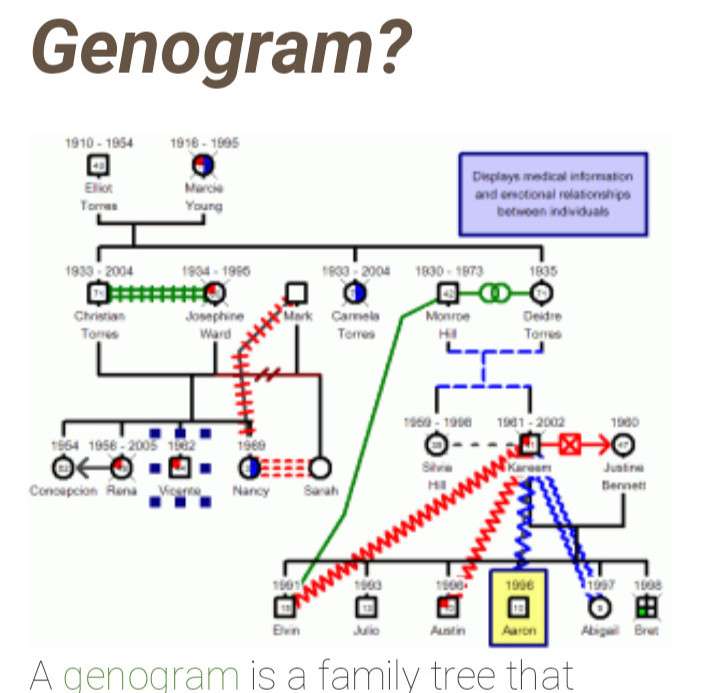
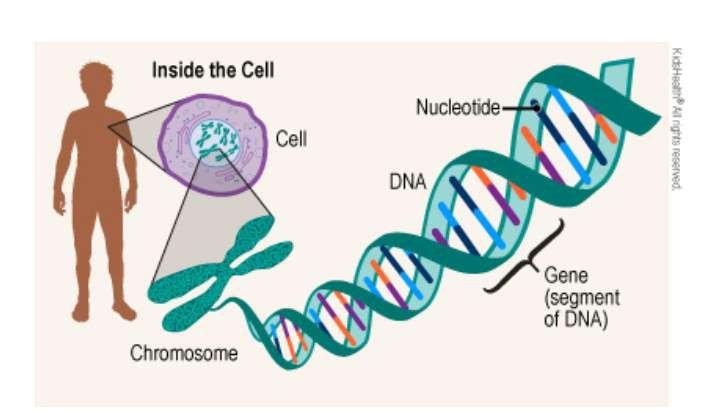
Awesome website you have here but I was wondering if you knew of any user discussion forums that cover the same topics talked about in this article? I’d really love to be a part of community where I can get feedback from other experienced people that share the same interest. If you have any suggestions, please let me know. Bless you!
Hi there.
I highly recommend Subreddits. This is a community on the Reddit websit. You can check out any topic and join in whenever you like.
You can sign up on Reddit.com. After I finish writing my book, I may start a group on social media; maybe on Medium.
You can also check out GenoPro. Let me know how it goes.
Happy New Year!
Rachele
rovingwithrachele.com
Only wanna comment on few general things, The website design is perfect, the written content is really wonderful : D.